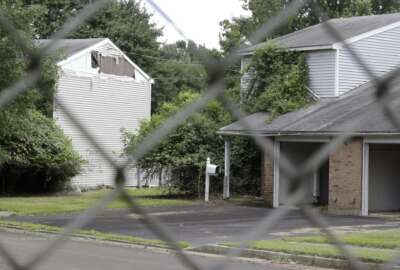
Army, Navy see drops in overall satisfaction with privatized military housing amid scandals
As the military deals with reports of mice, mold and lead paint in privatized housing, the Army and Navy saw a decline in overall satisfaction with the homes.
The Army and Navy are seeing across the board declines in satisfaction with privatized military housing compared to last year, according to two new surveys released by the services Thursday.
The results of the surveys come after reports of mice, mold and lead paint in privatized housing and a military-wide effort to fix issues with substandard housing.
“Each and every resident experience is an indicator for performance, and our goal is to proactively provide the quality expected rather than responding to issues that never should have been present in the first place. Across the board, every stakeholder is working in this direction, and our commitment remains to provide quality, safe housing to our service members and their families,” said Vice Adm. Mary Jackson, leader of Navy Installations Command.
The Navy saw an overall satisfaction score 11.6 points lower than 2018, placing the rating in the low average grade with 70.1 points. The Army saw a shift in the overall satisfaction score drop by nearly six points from 80.5 to 74.6, moving the score from very good to average.
The surveys, performed by third-party company CEL and Associates, used a proprietary score on a 100 point scale to judge installations from outstanding to crisis. The score factored in property quality and service attributes like readiness of companies to solve problems, responsiveness, quality of maintenance and quality of management services.
Army
This year’s survey saw a shift from privatized housing on most Army installations receiving outstanding, very good or good scores to good, average and below average scores.
Only three installations received outstanding scores: Ft. Greely, Ft. Huachuca and Picatinny Arsenal. Ft. Bragg was the only installation to receive a very poor rating and Fts. Carson and Meade received poor ratings.
Property satisfaction dropped 6.4 points from good to average and service satisfaction dropped 6 points from 81.9 to 75.9, going from very good to average.
All of the areas surveyed to create the overall score saw a drop in satisfaction from 3.6 to 6.5 points.
The survey polled 43 installations and 381 neighborhoods. A total of 79,388 surveys were distributed and 23,431 were received.
Housing falling in the average and below category are owned by a handful of different management companies including Corvias, Balfour-Beatty Communities, Lincoln Military Housing, The Michaels Organization, Clark Reality Capital and Lendlease.
Corvias is in charge of Ft. Bragg, which received the very poor rating and Ft. Meade, which received a poor rating. Balfour-Beatty Communities is in charge of Ft. Carson housing, which received a poor rating.
Corvias spokeswoman Kelly Douglas told Federal News Network that the aging infrastructure is part of the problem for poor housing conditions.
“Roughly 55% of our housing portfolio consists of homes built prior to the 2000s,” Douglas said in a statement. “At Fort Meade, 57% of the homes were built before 1978 and 43% were built between 1960 or earlier. Renovating these homes is a necessity, not a luxury.”
Top concerns of soldiers and their families included pest control, conditions of the roads, parking areas and sidewalks.
Navy
The Navy saw even more of its installations rated in the lower grades. The Navy surveyed 10 projects, and 42 installations. Five of those installations were rated poor or very poor.
The Navy did not disclose which installations were in the survey or which received each grade.
“Project names are redacted because the Navy’s business agreements with our private housing partners limit the type of information we can release publicly,” a Navy press release said.
The project scores ranged from 78.6 to 63.4. The Navy is taking action on areas with average scores or below.
“Property managers of neighborhoods that received an Overall Satisfaction Index score less than 75 points (“Average” or below) are required to submit an action plan to address issues noted in the “out of cycle” survey. The action plans will be reviewed and approved by the Navy. Concurrently, the Navy Housing Service Center will develop action plans to ensure all concerns are addressed regardless of score,” the Navy statement said.
“We continue to improve our existing processes and make changes that are designed to enhance our residents’ housing experience and quality of life,” said Greg Wright, Navy Installations Command housing director. “The survey results confirmed that many of our immediate actions were focused on the correct areas, and the results provided a more in-depth look at other areas of concern.”
The Navy survey came along with recommendations to mitigate issues with military housing given recent developments.
The recommendations include continuing to work with companies to determine and resolve top resident issues and correct all health and safety issues.
The report also suggests determining health and safety processes going forward and how they should be documented.
It says Navy Installations Command should establish an action plan process to determine how Navy Installations Command will work with private companies to solve issues and require staff to attend training on those plans.
Finally, the report states the Navy should educate its residents on how basic allowance for housing is handled and safety processes.
Some sailors and their families were not well educated on who works on their behalf.
In one of the supplemental questions, 39% of respondents were not aware that the Navy Housing Service Center is their advocate for on and off installation housing including privatized housing.
“We need to do a better job to ensure that service members and their families are aware of the resources available to them,” said Wright. “The government employees at the installation Navy Housing Service Centers are a wealth of knowledge and experience, and are trained to help residents resolve housing issues as quickly as possible.”
Copyright © 2024 Federal News Network. All rights reserved. This website is not intended for users located within the European Economic Area.
Scott Maucione is a defense reporter for Federal News Network and reports on human capital, workforce and the Defense Department at-large.
Follow @smaucioneWFED






